Effects of Climate Change on Streamflow in the Ayazma River Basin in the Marmara Region of Turkey
Abstract
:1. Introduction
2. Materials and Methods
2.1. Study Area
2.2. Data
2.3. Climate Models
2.4. The Mann–Kendall Trend Test
2.5. The Standardized Precipitation–Evapotranspiration Index (SPEI)
2.6. Hydrological Models
2.7. The HBV-Light Model
2.8. Hydrological Model Calibration and Validation
2.8.1. The HBV-Light Model
2.8.2. Goodness of Fit Tests
- -
- Nash–Sutcliffe Model Efficiency Coefficient (NSE): NSE is a normalized statistic that determines the relative magnitude of residual variance (i.e., noise) compared to the measured data variance (i.e., information). It varies between −∞ and 1 and is calculated by the relationship given in Equation (11) [56].
- -
- Coefficient of Determination (R2): Ranging from 0 to 1, R2 defines the ratio of variance in the measured data described by the model (Equation (12)). Higher values indicate less error variance, and typically values greater than 0.5 are considered acceptable [55].where is the observed flow, is the simulated flow, is the average observed flow, is the average simulated flow and n is the total number of observations.
- -
- Root Mean Squared Error (RMSE): RMSE is one of the commonly used error index statistics. It expresses the average magnitude of the differences between the observation and model values (Equation (13)). For the results to be acceptable, the RMSE is expected to be close to 0 and smaller than the observation standard deviation [55].
3. Results
3.1. Precipitation and Temperature Projections
3.2. The Mann–Kendall Trend Test Results
3.3. Meteorological Drought Assessment with the SPEI Method
3.4. Calibration and Validation of the HBV-Light Model
3.5. Hydrological Model Simulations for Future Climate Change
4. Discussion
4.1. Analysis of Climate Model Projections
4.2. Assessment of Meteorological Droughts
4.3. Hydrological Modelling
5. Conclusions
Author Contributions
Funding
Data Availability Statement
Conflicts of Interest
References
- Yilmaz, A.G.; Imteaz, M.A. Impact of climate change on runoff in the upper part of the Euphrates basin. Hydrol. Sci. J. 2011, 56, 1265–1279. [Google Scholar] [CrossRef]
- Selek, B.; Tuncok, I.K. Effects of climate change on surface water management of Seyhan basin, Turkey. Environ. Ecol. Stat. 2014, 21, 391–409. [Google Scholar] [CrossRef]
- Zhou, X.; Zhang, Y.; Yang, Y. Comparison of two approaches for estimating precipitation elasticity of streamflow in China’s main river basins. Adv. Meteorol. 2015, 2015, 924572. [Google Scholar] [CrossRef]
- Zhang, Y.; Li, H.; Reggiani, P. Climate variability and climate change impacts on land surface, hydrological processes and water management. Water 2019, 11, 1492. [Google Scholar] [CrossRef] [Green Version]
- Wang, H.; Yu, X. Sensitivity analysis of climate on streamflow in north China. Theor. Appl. Climatol. 2015, 119, 391–399. [Google Scholar] [CrossRef]
- Brunner, L.; Lorenz, R.; Zumwald, M.; Knutti, R. Quantifying uncertainty in European climate projections using combined performance-independence weighting. Environ. Res. Lett. 2019, 14, 124010. [Google Scholar] [CrossRef]
- Middelkoop, H.; Daamen, K.; Gellens, D.; Grabs, W.; Kwadijk, J.C.J.; Lang, H.; Parmet, B.W.A.H.; Schädler, B.; Schulla, J.; Wilke, K. Impact of climate change on hydrological regimes and water resources management in the Rhine basin. Clim. Chang. 2001, 49, 105–128. [Google Scholar] [CrossRef]
- Brunner, L.; Pendergrass, A.G.; Lehner, F.; Merrifield, A.L.; Lorenz, R.; Knutti, R. Reduced global warming from CMIP6 projections when weighting models by performance and independence. Earth Syst. Dyn. 2020, 11, 995–1012. [Google Scholar] [CrossRef]
- De Girolamo, A.M.; Bouraoui, F.; Buffagni, A.; Pappagallo, G.; Lo Porto, A. Hydrology under climate change in a temporary river system: Potential impact on water balance and flow regime. River Res. Appl. 2017, 33, 1219–1232. [Google Scholar] [CrossRef]
- Edenhofer, O.; Pichs-Madruga, R.; Sokona, Y.; Farahani, E.; Kadner, S.; Seyboth, K.; Adler, A.; Baum, I.; Brunner, S.; Eickemeier, P.; et al. IPCC, Mitigation of Climate Change. Contribution of Working Group III to the Fifth Assessment Report of the Intergovernmental Panel on Climate Change; Cambridge University Press: Cambridge, UK; New York, NY, USA, 2014. [Google Scholar]
- Gebrechorkos, S.H.; Bernhofer, C.; Hülsmann, S. Climate change impact assessment on the hydrology of a large river basin in Ethiopia using a local-scale climate modelling approach. Sci. Total Environ. 2020, 742, 140504. [Google Scholar] [CrossRef]
- Yang, W.; Andréasson, J.; Graham, L.P.; Olsson, J.; Rosberg, J.; Wetterhall, F. Distribution-based scaling to improve usability of regional climate model projections for hydrological climate change impacts studies. Hydrol. Res. 2010, 41, 211–229. [Google Scholar] [CrossRef]
- Tan, M.L.; Juneng, L.; Tangang, F.T.; Samat, N.; Chan, N.W.; Yusop, Z.; Ngai, S.T. SouthEast Asia HydrO-meteorological droughT (SEA-HOT) framework: A case study in the Kelantan River Basin, Malaysia. Atmos. Res. 2020, 246, 105155. [Google Scholar] [CrossRef]
- Bozkurt, D.; Turuncoglu, U.; Sen, O.L.; Onol, B.; Dalfes, N. Downscaled simulations of the ECHAM5, CCSM3 and HadCM3 global models for the eastern Mediterranean-Black Sea region: Evaluation of the reference period. Clim. Dyn. 2012, 39, 1–19. [Google Scholar] [CrossRef]
- Turkes, M.; Turp, M.T.; An, N.; Ozturk, T.; Kurnaz, M.L. Impacts of Climate Change on Precipitation Climatology and Variability in Turkey. In Water Resources of Turkey; Harmancioglu, N., Altinbilek, D., Eds.; World Water Resources; Springer: Cham, Switzerland, 2020; Volume 2. [Google Scholar] [CrossRef]
- Bozkurt, D.; Sen, O.L. Climate change impacts in the Euphrates–Tigris Basin based on different model and scenario simulations. J. Hydrol. 2013, 480, 149–161. [Google Scholar] [CrossRef]
- The Turkish General Directorate of Water Management (SYGM). Impact of Climate Change on Water Resources Project (In Turkish); The Ministry of Forest and Water Works of Turkey: Ankara, Turkey, 2016. Available online: https://www.tarimorman.gov.tr/SYGM/Belgeler/iklim%20de%C4%9Fi%C5%9Fikli%C4%9Finin%20su%20kaynaklar%C4%B1na%20etkisi/Iklim_NihaiRapor.pdf (accessed on 20 December 2022).
- Gorguner, M.; Kavvas, M.L.; Ishida, K. Assessing the impacts of future climate change on the hydroclimatology of the Gediz Basin in Turkey by using dynamically downscaled CMIP5 projections. Sci. Total Environ. 2019, 648, 481–499. [Google Scholar] [CrossRef]
- Gorguner, M.; Kavvas, M.L. Modeling impacts of future climate change on reservoir storages and irrigation water demands in a Mediterranean basin. Sci. Total Environ. 2020, 748, 141246. [Google Scholar] [CrossRef]
- Yıldırım, Ü.; Güler, C.; Önol, B.; Rode, M.; Jomaa, S. Modelling of the Discharge Response to Climate Change under RCP8.5 Scenario in the Alata River Basin (Mersin, SE Turkey). Water 2021, 13, 483. [Google Scholar] [CrossRef]
- Pilevneli, T.; Capar, G.; Sánchez-Cerdà, C. Investigation of climate change impacts on agricultural production in Turkey using volumetric water footprint approach. Sustain. Prod. Consum. 2023, 35, 605–623. [Google Scholar] [CrossRef]
- Yılmaz, M.; Alp, H.; Tosunoğlu, F.; Aşıkoğlu, Ö.L.; Eriş, E. Impact of climate change on meteorological and hydrological droughts for Upper Coruh Basin, Turkey. Nat. Hazards 2022, 112, 1039–1063. [Google Scholar] [CrossRef]
- Cilek, A.; Berberoglu, S.; Kirkby, M.; Irvine, B.; Donmez, C.; Erdogan, M.A. Erosion modelling in a Mediterranean subcatchment under climate change scenarios using Pan-European Soil Erosion Risk Assessment (PESERA). The International Archives of the Photogrammetry, Remote Sensing and Spatial Information Sciences, Volume XL-7/W3. In Proceedings of the 2015 36th International Symposium on Remote Sensing of Environment, Berlin, Germany, 11–15 May 2015; ISPRS: Hannover, Germany, 2015. [Google Scholar]
- Giorgi, F. Climate change hot-spots. Geophys. Res. Lett. 2006, 33, L08707. [Google Scholar] [CrossRef]
- IPCC. Summary for Policymakers. In Climate Change 2007: The Physical Science Basis. Contribution of Working Group I to the Fourth Assessment Report of the Intergovernmental Panel on Climate Change; Solomon, S., Qin, D., Manning, M., Chen, Z., Marquis, M., Averyt, K., Tignor, M., Miller, H., Eds.; Cambridge University Press: Cambridge, UK; New York, NY, USA, 2007. [Google Scholar]
- Giorgi, F.; Lionello, P. Climate change projections for the Mediterranean region. Glob. Planet. Chang. 2008, 63, 90–104. [Google Scholar] [CrossRef]
- Ciscar, J.C.; Ibarreta, D.R.; Soria, A.R.; Feyen, L. Climate Impacts in Europe: Final Report of the JRC PESETA III; Publications Office of the European Union: Luxembourg, 2018. [Google Scholar]
- The Swedish Meteorological and Hydrological Institute. 2014. Available online: https://www.smhi.se/ (accessed on 10 October 2022).
- van Meijgaard, E.; van Ulft, L.H.; van de Berg, W.J.; Bosveld, F.C.; van den Hurk, B.J.J.M.; Lenderink, G.; Siebesma, A.P. The KNMI Regional Atmospheric Climate Model RACMO Version 2.1; KNMI Technical Report-302; KNMI: De Bilt, Netherland, 2008. [Google Scholar]
- Kotlarski, S.; Keuler, K.; Christensen, O.B.; Colette, A.; Déqué, M.; Gobiet, A.; Goergen, K.; Jacob, D.; Lüthi, D.; Van Meijgaard, E.; et al. Regional climate modeling on European scales: A joint standard evaluation of the EURO-CORDEX RCM ensemble. Geosci. Model Dev. 2014, 7, 1297–1333. [Google Scholar] [CrossRef] [Green Version]
- Hırca, T.; Eryılmaz Türkkan, G.; Niazkar, M. Applications of innovative polygonal trend analyses to precipitation series of Eastern Black Sea Basin, Turkey. Theor. Appl. Climatol. 2022, 147, 651–667. [Google Scholar] [CrossRef]
- Hamed, K.H. Trend detection in hydrologic data: The Mann- Kendall trend test under the scaling hypothesis. J. Hydrol. 2008, 349, 350–363. [Google Scholar] [CrossRef]
- Vicente-Serrano, S.M.; Beguería, S.; López-Moreno, J.I. A multiscalar drought index sensitive to global warming: The standardized precipitation evapotranspiration index. J. Clim. 2010, 23, 1696–1718. [Google Scholar] [CrossRef] [Green Version]
- Tirivarombo, S.; Osupile, D.; Eliasson, P. Drought Monitoring and Analysis: Standardised Precipitation Evapotranspiration Index (SPEI) and Standardised Precipitation Index (SPI). Phys. Chem. Earth Parts A/B/C 2018, 106, 1–10. [Google Scholar] [CrossRef]
- Mathbout, S.; Lopez-Bustins, J.A.; Martin-Vide, J.; Bech, J.; Rodrigo, F.S. Spatial and temporal analysis of drought variability at several time scales in Syria during 1961–2012. Atmos. Res. 2018, 200, 153–168. [Google Scholar] [CrossRef]
- Thornthwaite, C.W. An approach toward a rational classification of climate. Geogr. Rev. 1948, 38, 55–94. [Google Scholar] [CrossRef]
- Kumanlioglu, A.A. Characterizing meteorological and hydrological droughts: A case study of the Gediz river basin, Turkey. Meteorol. Appl. 2020, 27, 1–17. [Google Scholar] [CrossRef]
- Pei, Z.; Fang, S.; Wang, L.; Yang, W. Comparative analysis of drought indicated by the SPI and SPEI at various timescales in Inner Mongolia, China. Water 2020, 12, 1925. [Google Scholar] [CrossRef]
- Arnold, J.G.; Fohrer, N. SWAT2000: Current capabilities and research opportunities in applied watershed modelling. Hydrol. Process. 2005, 19, 563–572. [Google Scholar] [CrossRef]
- Todini, E. Hydrological catchment modelling: Past, present and future. Hydrol. Earth Syst. Sci. 2007, 11, 468–482. [Google Scholar] [CrossRef] [Green Version]
- Arnold, J.G.; Srinivasan, R.; Muttiah, R.S.; Williams, J.R. Large area hydrologic modeling and assessment: Part I. Model development. J. Am. Water Resour. Assoc. (JAWRA) 1998, 34, 73–89. [Google Scholar] [CrossRef]
- Krysanova, V.; Hattermann, F.; Wechsung, F. Development of the ecohydrological model SWIM for regional impact studies and vulnerability assessment. Hydrol. Process. 2005, 19, 763–783. [Google Scholar] [CrossRef]
- Lindström, G.; Pers, C.; Rosberg, J.; Strömqvist, J.; Arheimer, B. Development and testing of the HYPE (Hydrological Predictions for the Environment) water quality model for different spatial scales. Hydrol. Res. 2010, 41, 295–319. [Google Scholar] [CrossRef]
- Nonki, R.M.; Lenouo, A.; Tshimanga, R.M.; Donfack, F.C.; Tchawoua, C. Performance assessment and uncertainty prediction of a daily time-step HBV-Light rainfall-runoff model for the Upper Benue River Basin, Northern Cameroon. J. Hydrol. Reg. Stud. 2021, 36, 100849. [Google Scholar] [CrossRef]
- Maxander, O. The Impact of Different Evapotranspiration Models in Rainfall Runoff Modelling Using HBV-light: A Comparison of Six Different Evapotranspiration Models over Three Catchments in Sweden. Master’s Thesis, Division of Water Resources Engineering, Department of Building and Environmental Technology, Lund University, Lund, Sweden, 2021. [Google Scholar]
- Abebe Temesgen, A. Rainfall-runoff modeling: A comparative analyses: Semi distributed HBV Light and SWAT models in Geba catchment, Upper Tekeze Basin, Ethiopia. Civ. Environ. Res. 2019, 11, 23–33. [Google Scholar]
- Bergström, S. Development and Application of a Conceptual Runoff Model for Scandinavian Catchments; RHO, Report Hydrology and Oceanography; SMHI: Norrköping, Sweden, 1976; Volume 7, p. 162. [Google Scholar]
- Bergström, S. Parametervärden för HBV-modellen i Sverige. Erfarenheter från modelkalibreringar under perioden 1975–1989. SMHI Hydrol. 1990, 28, 36. [Google Scholar]
- Bergström, S. The HBV Model—Its Structure and Applications; RH, Report Hydrology; Swedish Meteorological and Hydrological Institute: Norrköping, Sweden, 1992; Volume 4, p. 32. [Google Scholar]
- Seibert, J.; Vis, M.J.P. Teaching hydrological modeling with a user-friendly catchment-runoff-model software package. Hydrol. Earth Syst. Sci. 2012, 16, 3315–3325. [Google Scholar] [CrossRef] [Green Version]
- Killingtveit, A.; Fosdal, M.L. The River System Simulator—An integrated model system for water resources planning and operation transaction. WIT Trans. Ecol. Environ. 1994, 7, 8. [Google Scholar] [CrossRef]
- Zeckoski, R.W.; Smolen, M.D.; Moriasi, D.N.; Frankenberger, J.R.; Feyereisen, G.W. Hydrologic and water quality terminology as applied to modeling. Transactions of the ASABE 2015, 58, 1619–1635. [Google Scholar] [CrossRef]
- Zheng, C.; Hill, M.C.; Cao, G.; Ma, R. MT3DMS: Model use, calibration, and validation. Trans. ASABE 2012, 55, 1549–1559. [Google Scholar] [CrossRef]
- Kim, K.B.; Kwon, H.H.; Han, D. Exploration of warm-up period in conceptual hydrological modelling. J. Hydrol. 2018, 556, 194–210. [Google Scholar] [CrossRef] [Green Version]
- Moriasi, D.N.; Gitau, M.W.; Pai, N.; Daggupati, P. Hydrologic and water quality models: Performance measures and evaluation criteria. Trans. ASABE 2015, 58, 1763–1785. [Google Scholar] [CrossRef] [Green Version]
- Şen, Z.; Şişman, E.; Kızılöz, B. A new innovative method for model efficiency performance. Water Supply 2022, 22, 589–601. [Google Scholar] [CrossRef]
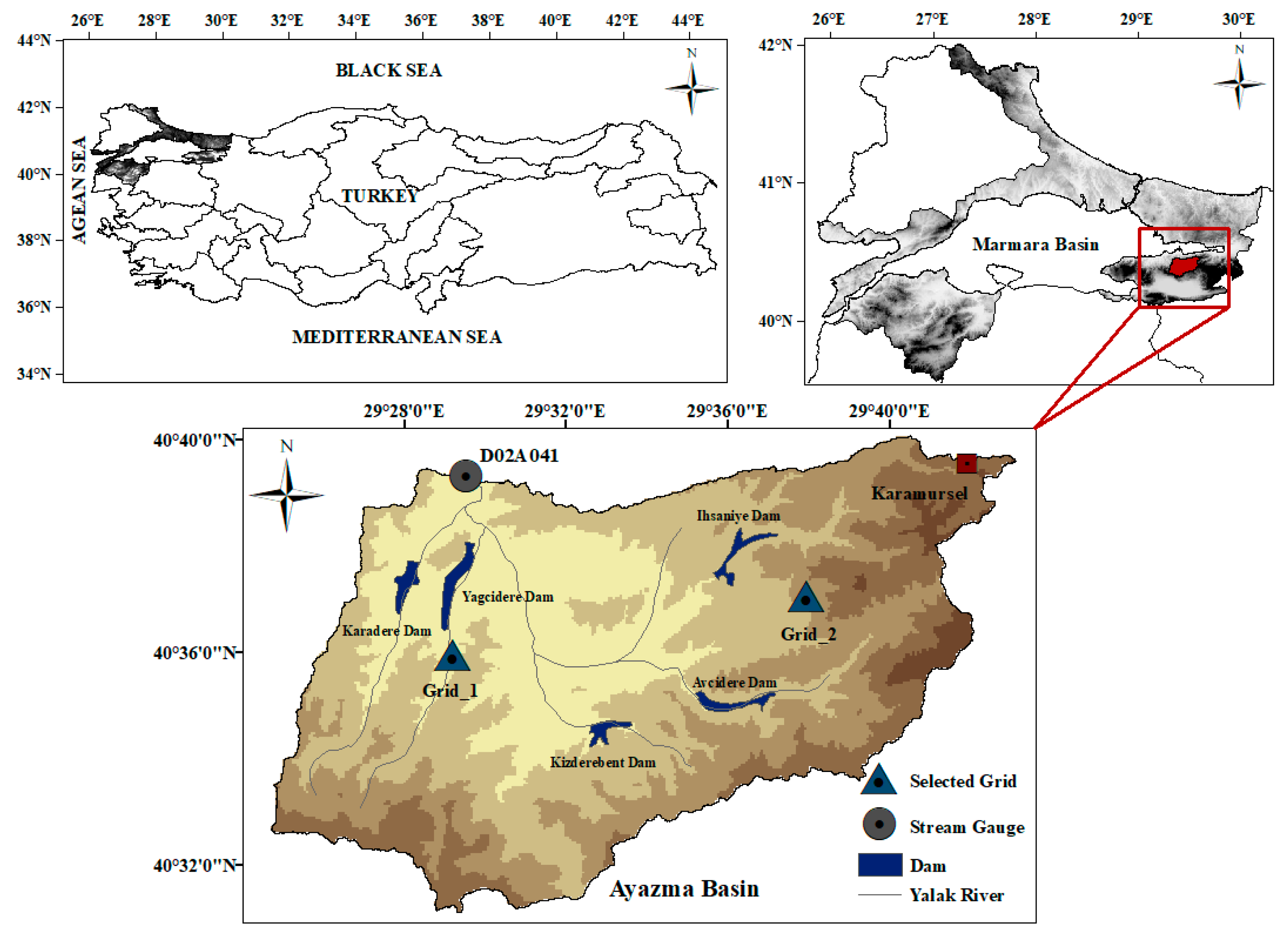
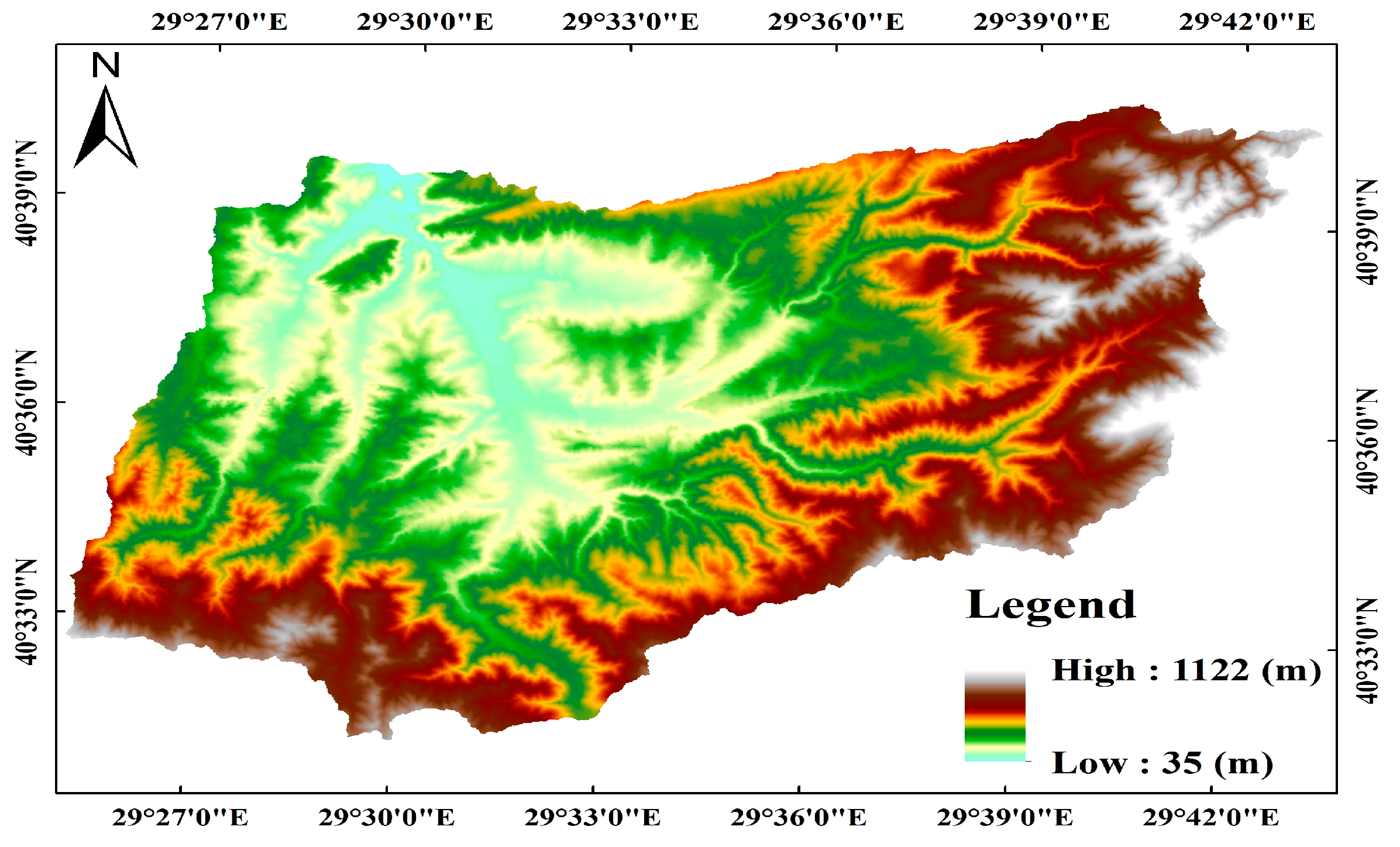
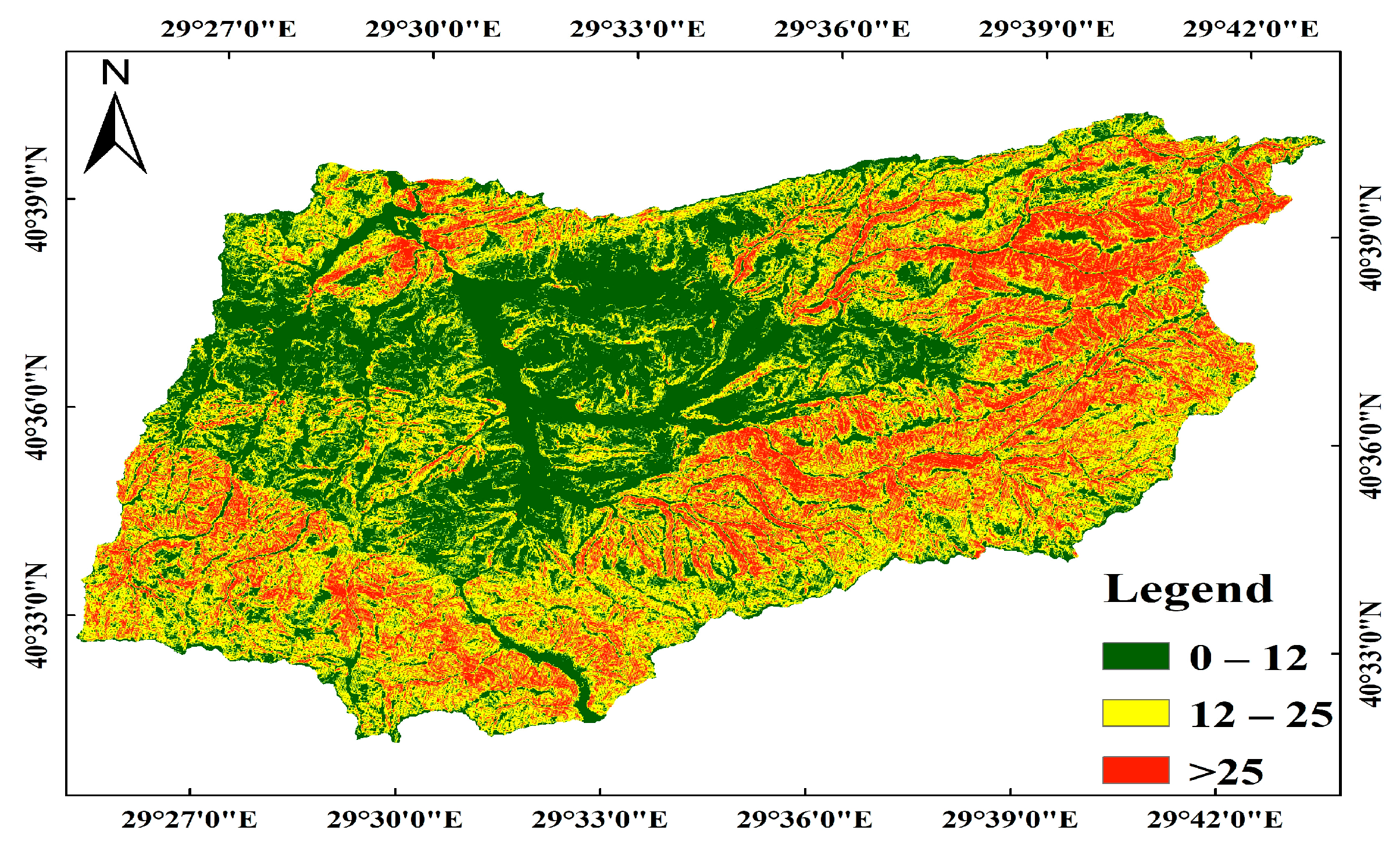






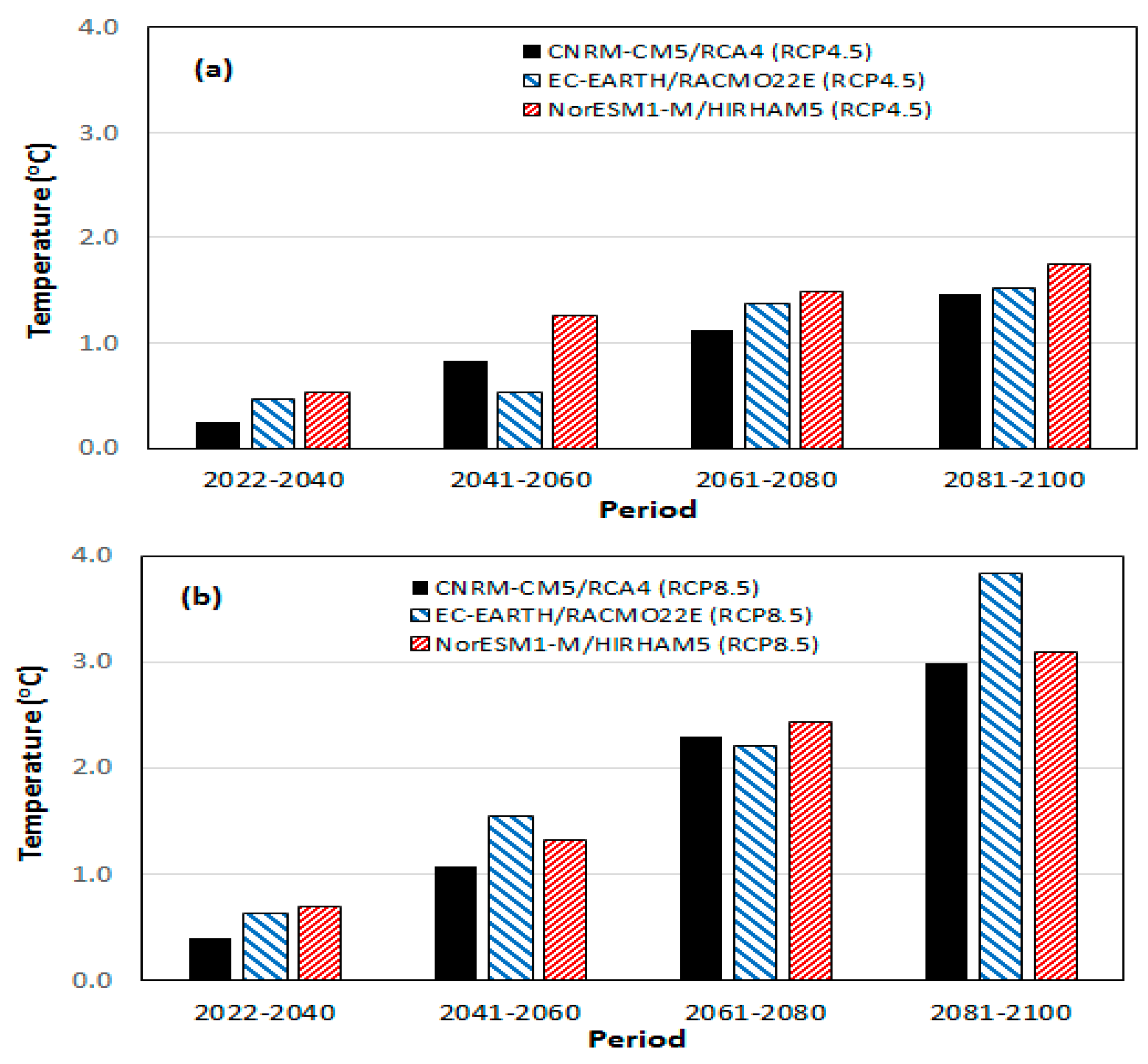
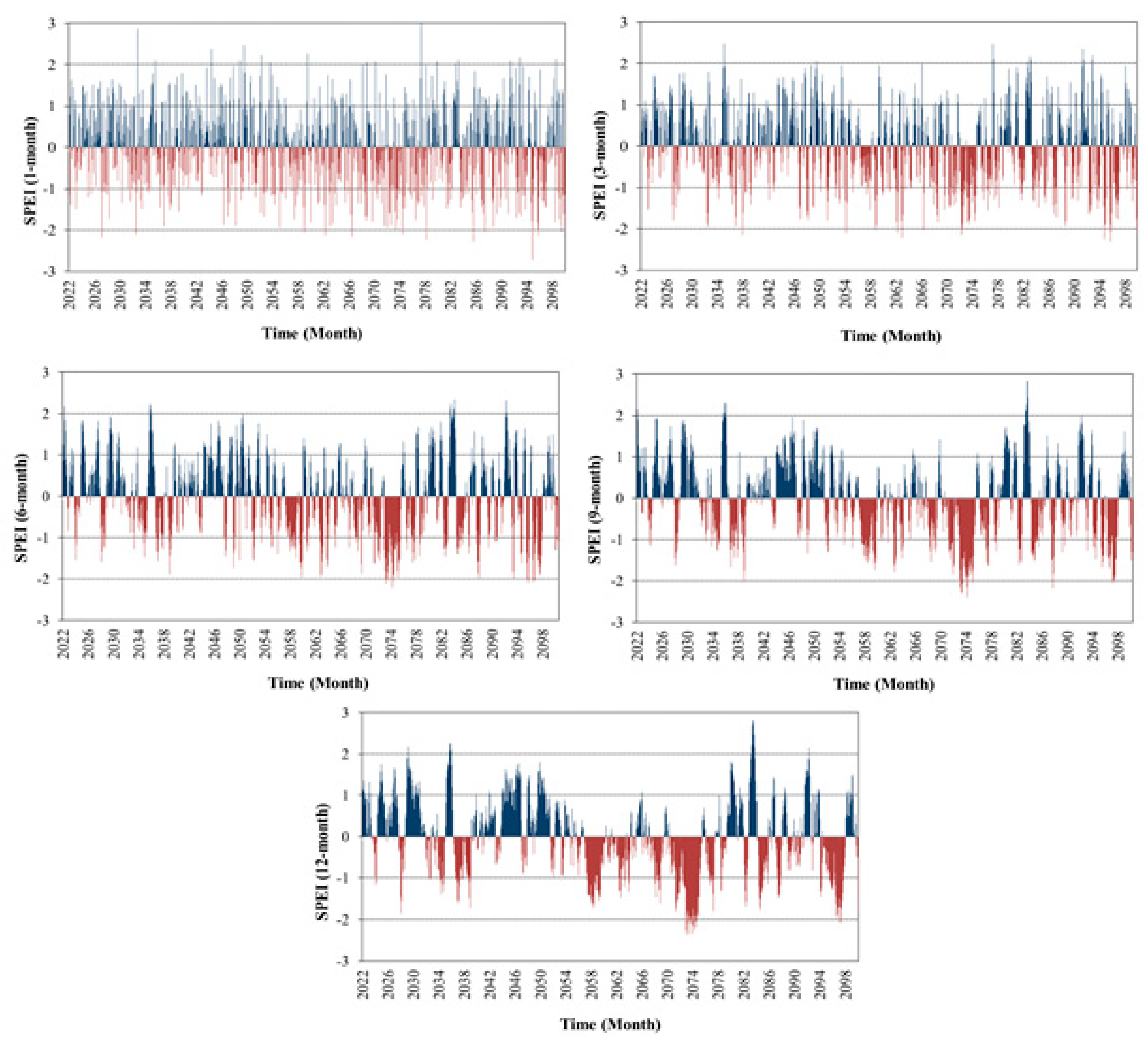




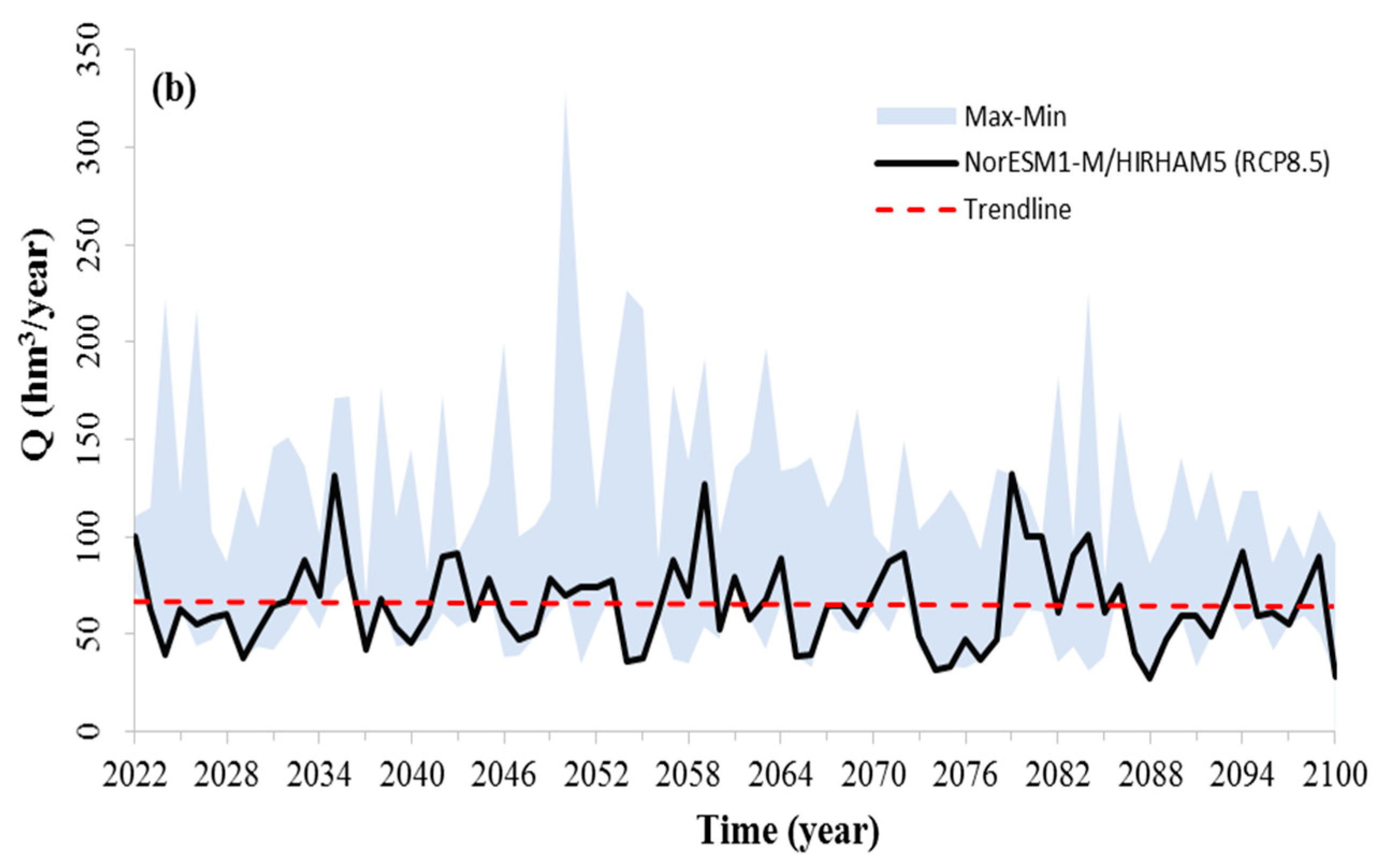
| GCM | Reference | RCM | Reference | Data Period | ||
|---|---|---|---|---|---|---|
| Observation Period | RCP4.5 Scenario | RCP8.5 Scenario | ||||
| CNRM-CM5 | CNRM, 2014, 2017 | RCA4 | [28] | 1970–2005 | 2006–2100 | 2006–2100 |
| EC-EARTH | EC-EARTH, 2022 | RACMO22E | [29] | 1950–2005 | 2006–2100 | 2006–2100 |
| NorESM1-M | NorESM, 2022 | HIRHAM5 | [30] | 1951–2005 | 2006–2100 | 2006–2100 |
| Parameter | Description | Range |
|---|---|---|
| TT | Threshold temperature | −2~2 |
| CFMAX | Degree-Δt factor | 4~0.01 |
| SP | Seasonal variability in degree-Δt factor | 0.1~0.001 |
| SFCF | Snowfall correction factor | 0.9~0.2 |
| CFR | Refreezing coefficient | 0.1~0.0001 |
| CWH | Water holding capacity | 0.2~0.0001 |
| FC | Maximum soil moisture storage | 500~50 |
| LP | Soil moisture value above which AET reaches PET | 1~0.3 |
| BETA | Parameter that determines the relative contribution to runoff from rain or snowmelt | 5~0.1 |
| PERC | Threshold parameter | 7~0 |
| UZL | Threshold parameter | 70~0 |
| K0 | Storage (or recession) coefficient 0 | 0.8~0.01 |
| K1 | Storage (or recession) coefficient 1 | 0.5~0.01 |
| K2 | Storage (or recession) coefficient 2 | 0.3~0.001 |
| MAXBAS | Length of triangular weighting function | 3~1 |
| Cet | Potential evaporation correction factor | 0.9~0 |
| PCALT | Increase in precipitation with elevation | 12~6 |
| TCALT | Decrease in temperature with elevation | 0.9~−0.9 |
| No | Area (km2) | Elevation (m) | % of Total Area | |||
|---|---|---|---|---|---|---|
| Minimum | Maximum | Mean | Standard Deviation | |||
| 1 | 125.44 | 35.00 | 303.00 | 191.01 | 63.36 | 47 |
| 2 | 85.87 | 304.00 | 541.00 | 415.75 | 68.05 | 32 |
| 3 | 56.62 | 542.00 | 1122.00 | 667.17 | 96.15 | 21 |
| Total | 267.93 | 100 | ||||
| GCM/RCM | RCP4.5 | RCP8.5 | ||||||
|---|---|---|---|---|---|---|---|---|
| Z | p | Trend Direction | Remark | Z | p | Trend Direction | Remark | |
| CNRM-CM5/RCA4 | 0.54 | 0.58 | + | NS | 1.24 | 0.21 | + | NS |
| EC-EARTH/RACMO22E | 0.19 | 0.84 | + | NS | 0.25 | 0.81 | + | NS |
| NorESM1-M/HIRHAM5 | −0.40 | 0.68 | − | NS | 0.49 | 0.62 | + | NS |
| GCM/RCM | RCP4.5 | RCP8.5 | ||||||
|---|---|---|---|---|---|---|---|---|
| Z | p | Trend Direction | Remark | Z | p | Trend Direction | Remark | |
| CNRM-CM5/RCA4 | 6.01 | 0.00 | + | S | 9.23 | 0.00 | + | S |
| EC-EARTH/RACMO22E | 4.96 | 0.00 | + | S | 8.60 | 0.00 | + | S |
| NorESM1-M/HIRHAM5 | 6.32 | 0.00 | + | S | 8.72 | 0.00 | + | S |
| Performance Measure | Calibration | Validation |
|---|---|---|
| NSE | 0.73 | 0.67 |
| R2 | 0.73 | 0.71 |
| RMSE | 4.36 | 5.94 |
| RCM | RCP Scenario | Qsim (hm3/Year) [2022–2100] | Qobs (hm3/Year) [1999–2015] |
|---|---|---|---|
| CNRM-CM5/RCA4 | RCP 4.5 | 79.59 | 79.12 |
| RCP 8.5 | 77.40 | ||
| EC-EARTH/RACMO22E | RCP 4.5 | 104.70 | |
| RCP 8.5 | 104.43 | ||
| NorESM1-M/HIRHAM5 | RCP 4.5 | 67.38 | |
| RCP 8.5 | 65.88 |
| RCM (RCP4.5) | ||||||
| CNRM-CM5/RCA4 | EC-EARTH/RACMO22E | NorESM1-M/HIRHAM5 | ||||
| Period | Flow (m3/s) | Anomaly | Flow (m3/s) | Anomaly | Flow (m3/s) | Anomaly |
| 2022–2040 | 86.16 | 7.04 | 102.08 | 22.96 | 79.60 | 0.48 |
| 2041–2060 | 75.30 | −3.82 | 120.28 | 41.16 | 61.53 | −17.59 |
| 2061–2080 | 79.84 | 0.72 | 99.83 | 20.71 | 64.18 | −14.94 |
| 2081–2100 | 77.41 | −1.71 | 96.48 | 17.36 | 64.83 | −14.29 |
| RCM (RCP8.5) | ||||||
| CNRM-CM5/RCA4 | EC-EARTH/RACMO22E | NorESM1-M/HIRHAM5 | ||||
| Period | Flow (m3/s) | Anomaly | Flow (m3/s) | Anomaly | Flow (m3/s) | Anomaly |
| 2022–2040 | 81.38 | 2.26 | 111.63 | 32.51 | 65.35 | −13.77 |
| 2041–2060 | 75.04 | −4.08 | 113.21 | 34.09 | 68.92 | −10.20 |
| 2061–2080 | 71.74 | −7.38 | 110.98 | 31.86 | 64.20 | −14.92 |
| 2081–2100 | 81.65 | 2.53 | 82.25 | 3.13 | 65.03 | −14.09 |
Disclaimer/Publisher’s Note: The statements, opinions and data contained in all publications are solely those of the individual author(s) and contributor(s) and not of MDPI and/or the editor(s). MDPI and/or the editor(s) disclaim responsibility for any injury to people or property resulting from any ideas, methods, instructions or products referred to in the content. |
© 2023 by the authors. Licensee MDPI, Basel, Switzerland. This article is an open access article distributed under the terms and conditions of the Creative Commons Attribution (CC BY) license (https://creativecommons.org/licenses/by/4.0/).
Share and Cite
Seddiqe, K.H.; Sediqi, R.; Yildiz, O.; Akturk, G.; Kostecki, J.; Gortych, M. Effects of Climate Change on Streamflow in the Ayazma River Basin in the Marmara Region of Turkey. Water 2023, 15, 763. https://doi.org/10.3390/w15040763
Seddiqe KH, Sediqi R, Yildiz O, Akturk G, Kostecki J, Gortych M. Effects of Climate Change on Streamflow in the Ayazma River Basin in the Marmara Region of Turkey. Water. 2023; 15(4):763. https://doi.org/10.3390/w15040763
Chicago/Turabian StyleSeddiqe, Khaja Haroon, Rahmatullah Sediqi, Osman Yildiz, Gaye Akturk, Jakub Kostecki, and Marta Gortych. 2023. "Effects of Climate Change on Streamflow in the Ayazma River Basin in the Marmara Region of Turkey" Water 15, no. 4: 763. https://doi.org/10.3390/w15040763
APA StyleSeddiqe, K. H., Sediqi, R., Yildiz, O., Akturk, G., Kostecki, J., & Gortych, M. (2023). Effects of Climate Change on Streamflow in the Ayazma River Basin in the Marmara Region of Turkey. Water, 15(4), 763. https://doi.org/10.3390/w15040763







